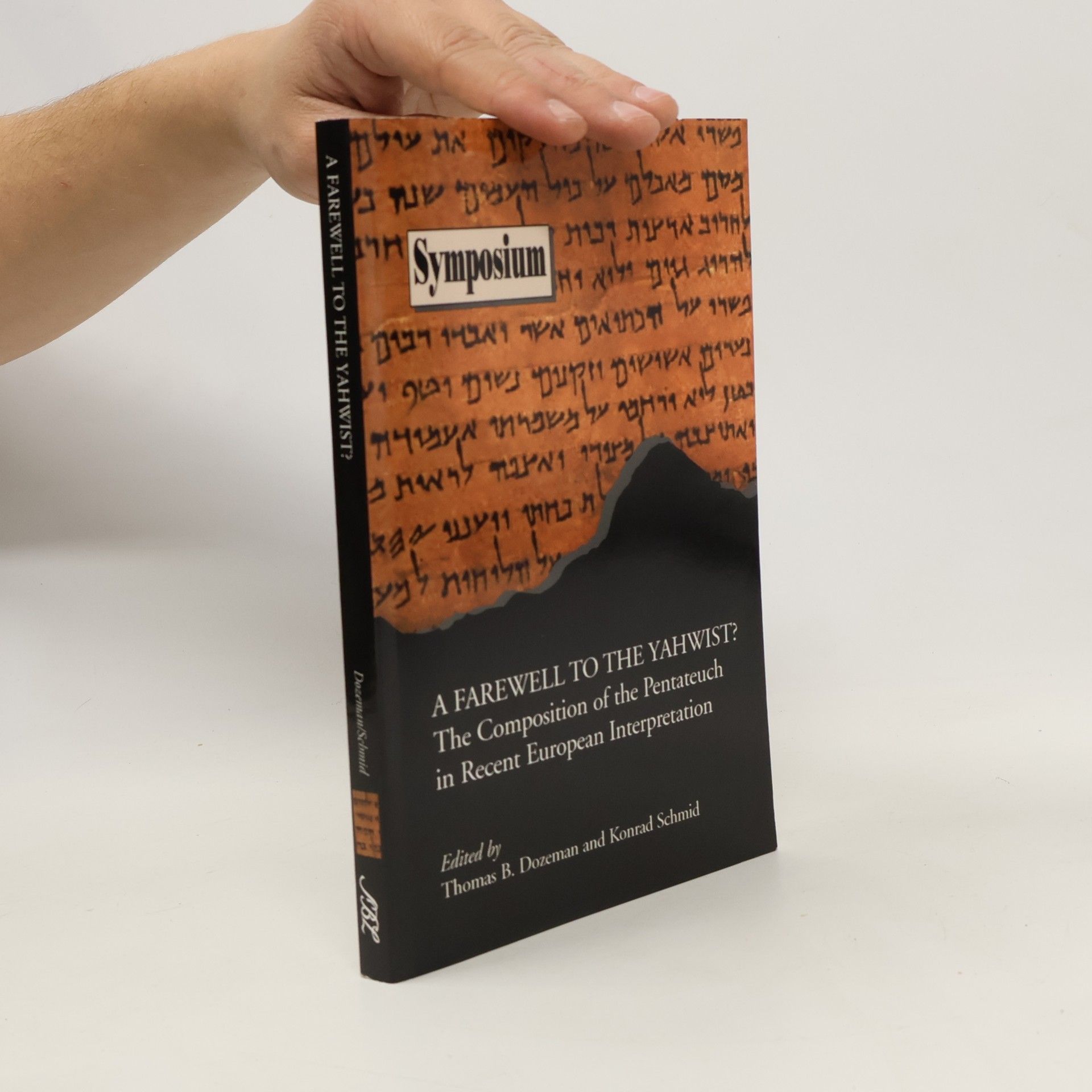The exploration of ancient texts reveals their evolution from folk tales to sacred scripture, challenging traditional views on the connections between the Old and New Testaments. Konrad Schmid and Jens Schröter investigate the historical context and transformation of these writings, offering new insights into their significance within Judaism and Christianity. Their analysis aims to reshape understanding of these foundational texts and their interrelatedness.
Konrad Schmid Boeken






This volume makes available both the most recent European scholarship on the Pentateuch and its critical discussion, providing a helpful resource and fostering further dialogue between North American and European interpreters. The contributors are Erhard Blum, David M. Carr, Thomas B. Dozeman, Jan Christian Gertz, Christoph Levin, Albert de Pury, Thomas Christian Roemer, Konrad Schmid, and John Van Seters.
The Bible is full of ancient texts long predating the assembly of Judaism's and Christianity's sacred books. Why these texts, and how were they transformed on the journey from folk tale to holy writ? Konrad Schmid and Jens Schroeter unearth the history, in the process overturning assumptions about the relationship between the Old and New Testaments.
The Scribes of the Torah
The Formation of the Pentateuch in Its Literary and Historical Contexts
- 954bladzijden
- 34 uur lezen
Focusing on the formation of the Pentateuch, this collection features thirty-one studies by Konrad Schmid, reflecting over two decades of research. Schmid argues for the existence of a Persian period Priestly document that serves as a foundational narrative for the Torah, while also highlighting distinct, pre-Priestly narrative elements in Genesis and the story of Moses. His essays advocate for a re-evaluation of traditional views on the composition of these biblical texts.
Deuteronomy in the Pentateuch, Hexateuch, and the Deuteronomistic history
- 179bladzijden
- 7 uur lezen
The earlier consensus concerning the Pentateuch and the Deuteronomistic History has been significantly challenged in recent scholarship. Because of its canonical placement, the book of Deuteronomy plays an important role in these discussions. The earlier consensus was that the D source in the Pentateuch was primarily (if not only) found in Deuteronomy and that Deuteronomy was the founding source for the Deuteronomistic History. Recently, however, some scholars are once again talking about the D source in books before and after Deuteronomy, while others are questioning the centrality of the D source for the formation of the so-called Deuteronomistic History. This volume brings together various voices in these recent debates concerning the role of Deuteronomy in the larger literary works incorporating material before and after the book of Deuteronomy. Contributors include Reinhard Kratz, Jeffrey Stackert, Sandra Richter, Christophe Nihan, Cynthia Edenburg, Juha Pakkala, and Konrad Schmid.
Im Horizont ökologischer Krisen, aber auch der Kreationismusdebatte ist Schöpfung in den letzten Jahrzehnten zu einem vielverhandelten Thema der Theologie geworden. Die Autoren der hier gesammelten Beiträge zeigen aus der Perspektive theologischer Einzeldisziplinen, aber auch in zusammenschauender Weise, wie Schöpfung in theologisch angemessener Weise gedacht werden kann.
Wie können wir das Alte Testament besser verstehen? Vor dem Hintergrund einer fast unübersehbar gewordenen Forschungslage wird hier eine zusammenfassende Darstellung der Literaturgeschichte der alttestamentlichen Texte versucht. Dazu wird vor allem verdeutlicht, in welcher historischen Situation diese Teile der Bibel entstanden sind, wie sie sich zu den anderen Zeugnissen der Zeit verhalten und welche Entwicklungsstufen für sie beschrieben werden können. Dabei werden die verschiedenen ›Schichtungen‹ sichtbar und es wird nachvollziehbar, warum sich der heute bekannte Text herausgebildet hat. Der Band diskutiert die verschiedenen Forschungsansätze zum Thema und ermöglicht so eine gründliche Orientierung in Forschung und Lehre.
Die Bibel vereint verschiedene Schriften aus über tausend Jahren und erscheint dennoch als ein einheitliches Werk. Konrad Schmid und Jens Schröter erläutern, wie aus alten Erzählungen, Liedern, Weisheitssprüchen, Gesetzen, Briefen an frühchristliche Gemeinden und Berichten über Jesus im Laufe der Zeit heilige Schriften von Juden und Christen entstanden sind, die heute weltweit gelesen werden. Ihr verständlich geschriebenes Werk bietet einen aktuellen Überblick über die Entstehung der Bibel, basierend auf den neuesten Forschungsergebnissen. In den letzten Jahrzehnten wurden viele gängige Annahmen über die Geschichte Israels und die Entstehung der Bibel überdacht. Ereignisse wie der Auszug aus Ägypten oder der Tempelbau unter König Salomo gelten nicht mehr als historisch. Dies wirft die Frage auf, wie die großen Geschichten des Alten Testaments entstanden sind und wann sie zu „heiligen Schriften“ wurden. Auch die Sammlung der Evangelien und frühe Apostelbriefe stehen nun zur Diskussion. Das Buch beschreibt den Weg von den frühen Erzählungen des alten Israel über Schlüsseltexte des jüdischen Monotheismus und des frühen Christentums bis hin zu den heiligen Büchern der Weltreligionen. Wer mehr über dieses überlieferungsgeschichtliche Wunder erfahren möchte, sollte diese Biographie des bekanntesten Buches der Welt lesen.
Recht und Religion
- 444bladzijden
- 16 uur lezen
Die Untersuchung beleuchtet die Wechselwirkungen zwischen religiösen Denkweisen und rechtlichen Konzeptionen. Sie analysiert, wie religiöse Überzeugungen das Verständnis von Recht und Gerechtigkeit prägen und umgekehrt, wie rechtliche Rahmenbedingungen religiöse Praktiken beeinflussen können. Der Autor geht auf verschiedene historische und kulturelle Kontexte ein, um die komplexen Beziehungen zwischen Religion und Recht zu verdeutlichen und bietet einen interdisziplinären Ansatz zur Betrachtung dieser Thematik.
Natur und Schöpfung
- 366bladzijden
- 13 uur lezen
Inmitten der Herausforderungen der Corona-Pandemie und der ökologischen Krise bietet das Buch ermutigende und provokante biblische Impulse. Es beleuchtet, wie Glaubensfragen und biblische Perspektiven in der heutigen Zeit relevant bleiben und zur Reflexion über unsere Beziehung zur Natur anregen. Die Autor*innen laden dazu ein, die Verklärung der Natur kritisch zu hinterfragen und neue Wege des Glaubens und Handelns zu erkunden, die sowohl spirituelle als auch ökologische Dimensionen berücksichtigen.

